door lock HONDA CIVIC COUPE 1999 Owners Manual
[x] Cancel search | Manufacturer: HONDA, Model Year: 1999, Model line: CIVIC COUPE, Model: HONDA CIVIC COUPE 1999Pages: 269, PDF Size: 2.42 MB
Page 4 of 269
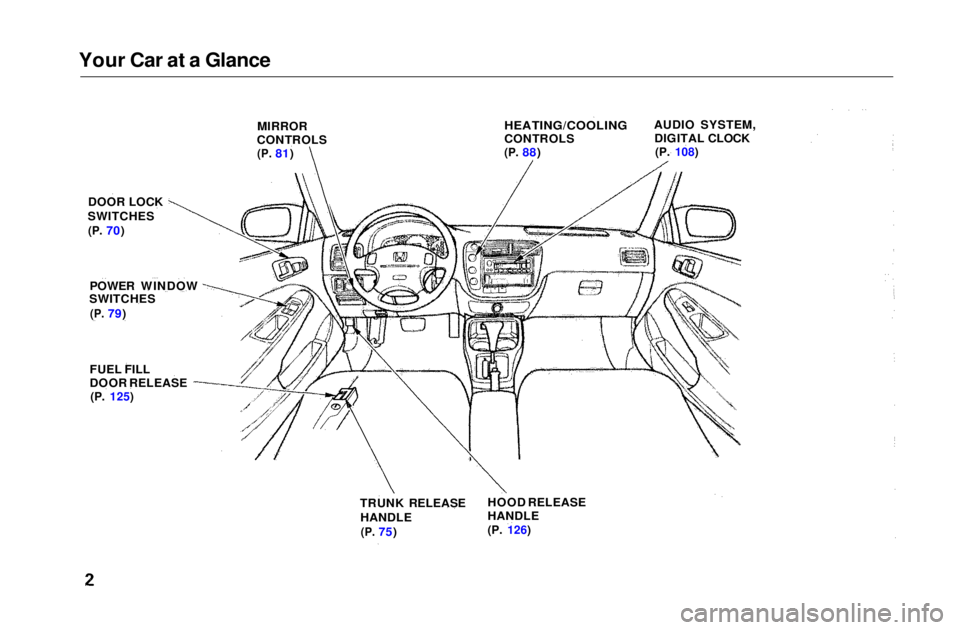
Your Car at a Glance
DOOR LOCK
SWITCHES
(P.
70) MIRROR
CONTROLS
(P.
81)
HEATING/COOLING
CONTROLS
(P.
88)
AUDIO SYSTEM,
DIGITAL CLOCK
(P. 108)
POWER WINDOW
SWITCHES
(P.
79)
FUEL FILL
DOOR RELEASE
(P. 125)
TRUNK RELEASEHANDLE
(P.
75) HOOD RELEASE
HANDLE
(P. 126)Main Menu s t
Page 6 of 269
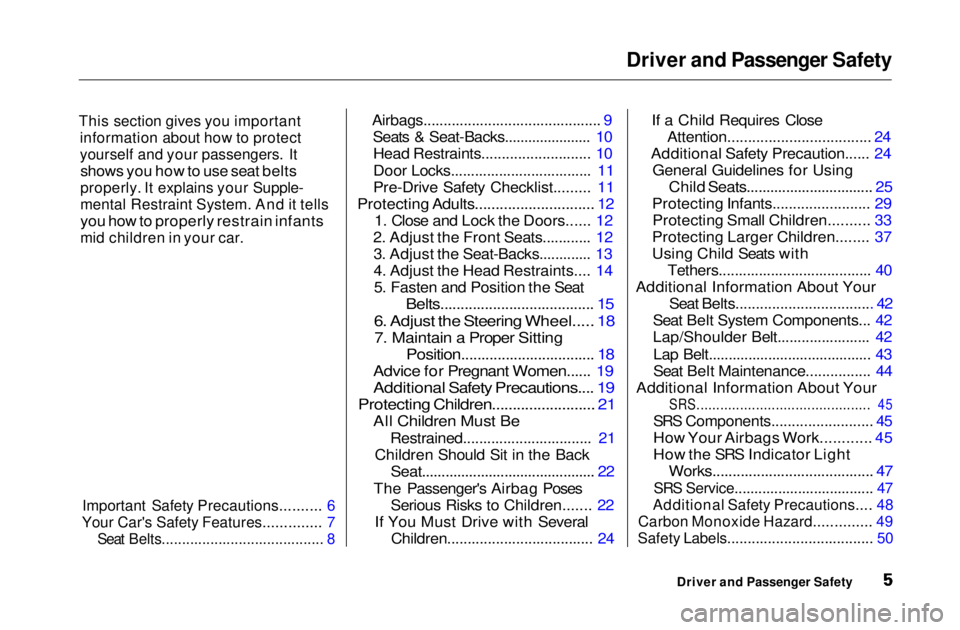
Driver and Passenger Safety
This section gives you important
information about how to protect
yourself and your passengers. It
shows you how to use seat belts
properly. It explains your Supple-
mental Restraint System. And it tells
you how to properly restrain infants
mid children in your car.
Important Safety Precautions.......... 6
Your Car's Safety Features.............. 7
Seat Belts........................................ 8
Airbags............................................ 9
Seats & Seat-Backs...................... 10Head Restraints........................... 10
Door Locks................................... 11
Pre-Drive Safety Checklist......... 11
Protecting Adults............................. 12
1. Close and Lock the Doors...... 12
2. Adjust the Front Seats............ 12 3. Adjust the Seat-Backs............. 13
4. Adjust the Head Restraints.... 145. Fasten and Position the Seat
Belts...................................... 15
6. Adjust the Steering Wheel..... 18
7. Maintain a Proper Sitting
Position................................. 18
Advice for Pregnant Women...... 19
Additional Safety Precautions.... 19
Protecting Children......................... 21
All Children Must Be
Restrained................................ 21
Children Should Sit in the Back
Seat............................................ 22
The Passenger's Airbag Poses Serious Risks to Children....... 22
If You Must Drive with Several Children.................................... 24 If a Child Requires Close
Attention................................... 24
Additional Safety Precaution...... 24 General Guidelines for Using
Child Seats................................ 25
Protecting Infants........................ 29 Protecting Small Children.......... 33
Protecting Larger Children........ 37
Using Child Seats with Tethers...................................... 40
Additional Information About Your
Seat Belts.................................. 42
Seat Belt System Components... 42
Lap/Shoulder Belt....................... 42
Lap Belt......................................... 43
Seat Belt Maintenance................ 44
Additional Information About Your
SRS............................................ 45
SRS Components......................... 45
How Your Airbags Work............ 45
How the SRS Indicator Light
Works........................................ 47
SRS Service................................... 47
Additional Safety Precautions.... 48
Carbon Monoxide Hazard.............. 49
Safety Labels.................................... 50
Driver and Passenger SafetyMain Menu s t
Page 8 of 269
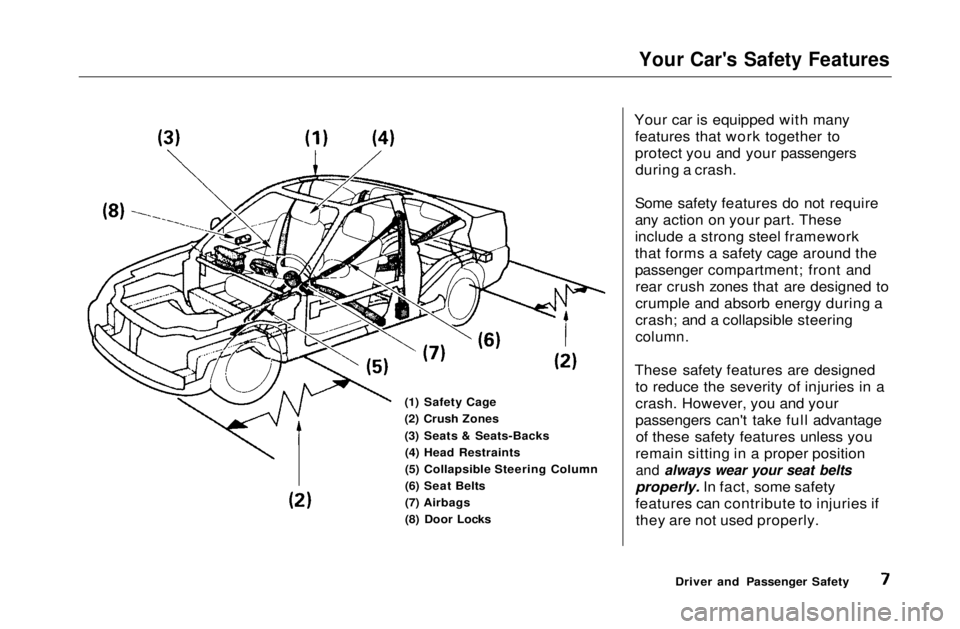
Your Car's Safety Features
Your car is equipped with many features that work together to
protect you and your passengersduring a crash.
Some safety features do not require
any action on your part. These
include a strong steel framework
that forms a safety cage around the
passenger compartment; front and rear crush zones that are designed to
crumple and absorb energy during a
crash; and a collapsible steering
column.
These safety features are designed to reduce the severity of injuries in a
crash. However, you and your
passengers can't take full advantageof these safety features unless you
remain sitting in a proper position
and always wear your seat belts
properly. In fact, some safety
features can contribute to injuries if they are not used properly.
Driver and Passenger Safety
(1) Safety Cage
(2) Crush Zones
(3) Seats & Seats-Backs
(4) Head Restraints
(5) Collapsible Steering Column
(6) Seat Belts
(7) Airbags
(8) Door LocksMain Menu Table of Contents s t
Page 12 of 269
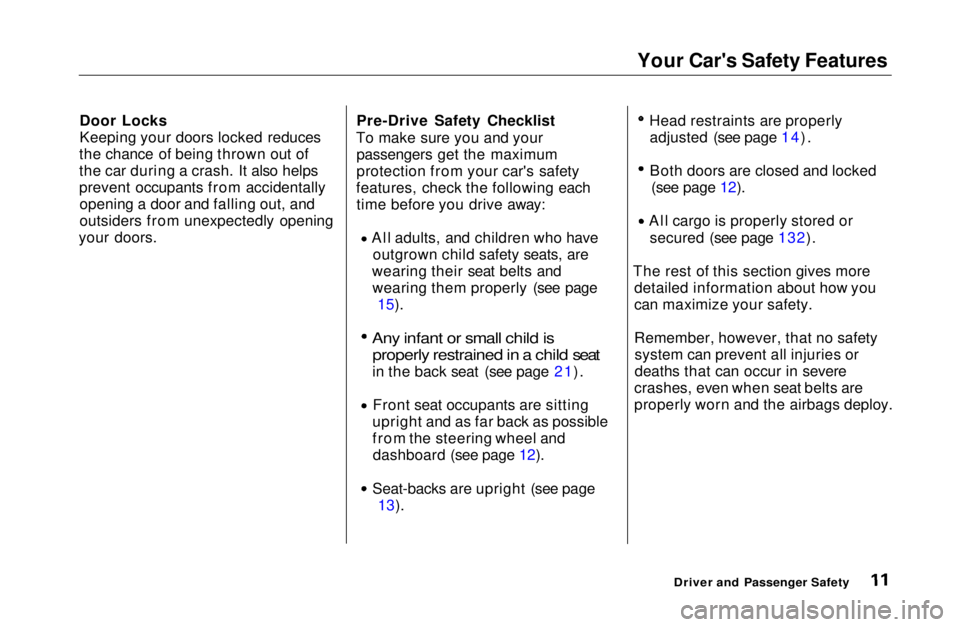
Your Car's Safety Features
Door Locks
Keeping your doors locked reduces
the chance of being thrown out of
the car during a crash. It also helps
prevent occupants from accidentally opening a door and falling out, and
outsiders from unexpectedly opening
your doors. Pre-Drive Safety Checklist
To make sure you and your passengers get the maximum
protection from your car's safety
features, check the following each time before you drive away: All adults, and children who have
outgrown child safety seats, are
wearing their seat belts and wearing them properly (see page 15).
Any infant or small child is
properly restrained in a child seat
in the back seat (see page 21). Front seat occupants are sitting
upright and as far back as possible
from the steering wheel and dashboard (see page 12). Seat-backs are upright (see page
13). Head restraints are properly
adjusted (see page 14). Both doors are closed and locked
(see page 12). All cargo is properly stored or
secured (see page 132).
The rest of this section gives more detailed information about how you
can maximize your safety.
Remember, however, that no safetysystem can prevent all injuries or
deaths that can occur in severe
crashes, even when seat belts are
properly worn and the airbags deploy.
Driver and Passenger SafetyMain Menu Table of Contents s t
Page 13 of 269
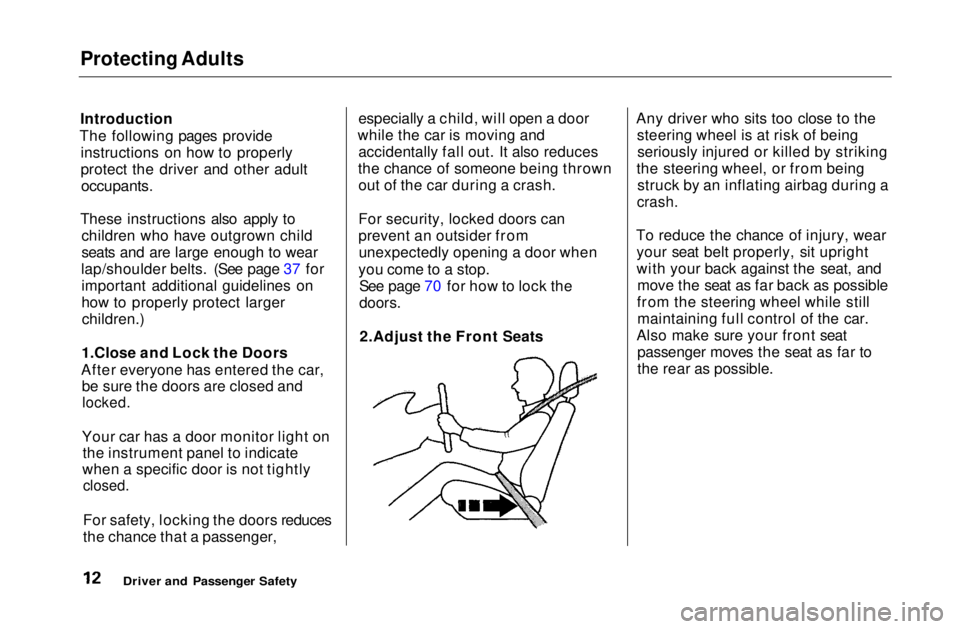
Protecting Adults
Introduction
The following pages provide instructions on how to properly
protect the driver and other adult
occupants.
These instructions also apply to children who have outgrown child
seats and are large enough to wear
lap/shoulder belts. (See page 37 for important additional guidelines on
how to properly protect largerchildren.)
1.Close and Lock the Doors
After everyone has entered the car, be sure the doors are closed and
locked.
Your car has a door monitor light on the instrument panel to indicate
when a specific door is not tightly
closed.
For safety, locking the doors reduces
the chance that a passenger, especially a child, will open a door
while the car is moving and accidentally fall out. It also reduces
the chance of someone being thrown out of the car during a crash.
For security, locked doors can
prevent an outsider fromunexpectedly opening a door when
you come to a stop. See page 70 for how to lock the
doors.
2.Adjust the Front Seats Any driver who sits too close to the
steering wheel is at risk of beingseriously injured or killed by striking
the steering wheel, or from being struck by an inflating airbag during a
crash.
To reduce the chance of injury, wear your seat belt properly, sit upright
with your back against the seat, and move the seat as far back as possible
from the steering wheel while still maintaining full control of the car.
Also make sure your front seat passenger moves the seat as far to
the rear as possible.
Driver and Passenger SafetyMain Menu Table of Contents s t
Page 43 of 269
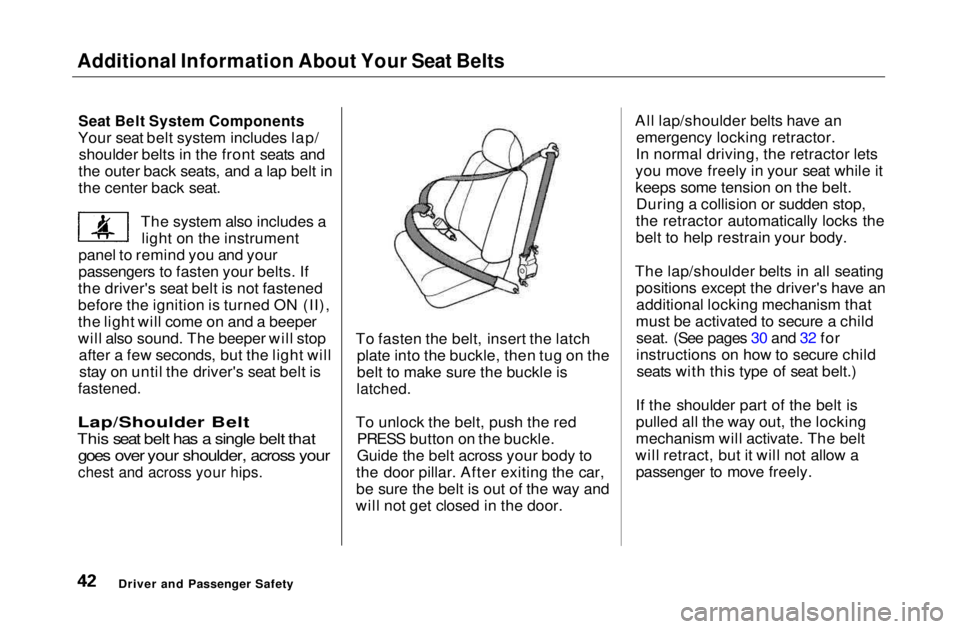
Additional Information About Your Seat Belts
Seat Belt System Components
Your seat belt system includes lap/ shoulder belts in the front seats and
the outer back seats, and a lap belt in
the center back seat.
The system also includes alight on the instrument
panel to remind you and your
passengers to fasten your belts. If
the driver's seat belt is not fastened
before the ignition is turned ON (II),
the light will come on and a beeper
will also sound. The beeper will stop after a few seconds, but the light willstay on until the driver's seat belt is
fastened.
Lap/Shoulder Belt
This sea t
belt has a single belt that
goes over your shoulder, across your
chest and across your hips.
To fasten the belt, insert the latch
plate into the buckle, then tug on the
belt to make sure the buckle is
latched.
To unlock the belt, push the red PRESS button on the buckle.
Guide the belt across your body to
the door pillar. After exiting the car,
be sure the belt is out of the way and
will not get closed in the door. All lap/shoulder belts have an
emergency locking retractor.
In normal driving, the retractor lets
you move freely in your seat while it
keeps some tension on the belt. During a collision or sudden stop,
the retractor automatically locks the
belt to help restrain your body.
The lap/shoulder belts in all seating positions except the driver's have anadditional locking mechanism that
must be activated to secure a child seat. (See pages 30 and 32 for
instructions on how to secure childseats with this type of seat belt.)
If the shoulder part of the belt is
pulled all the way out, the locking
mechanism will activate. The belt
will retract, but it will not allow a passenger to move freely.
Driver and Passenger SafetyMain Menu Table of Contents s t
Page 52 of 269
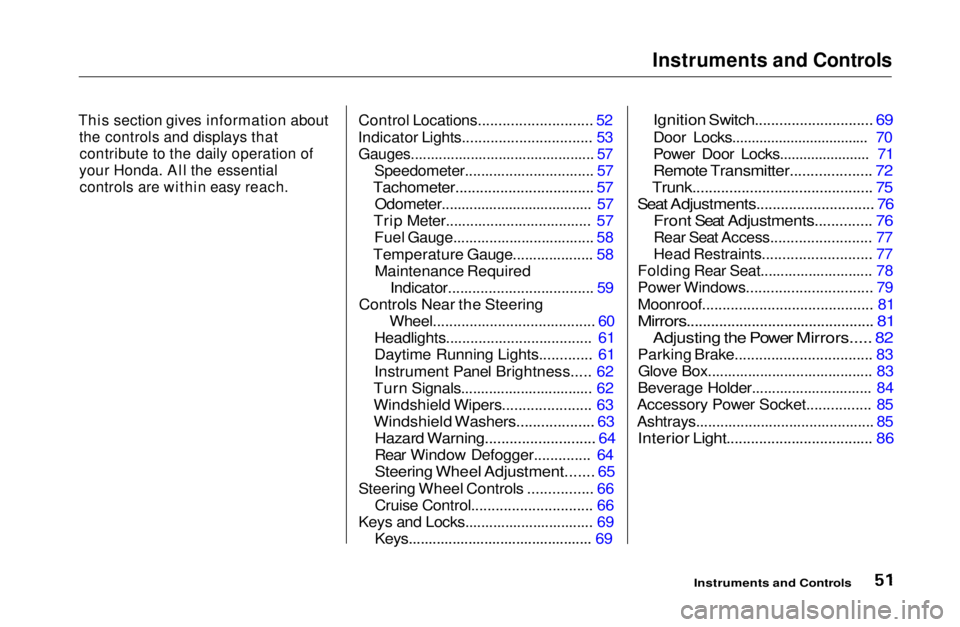
Instruments and Controls
This section gives information about
the controls and displays thatcontribute to the daily operation of
your Honda. All the essential
controls are within easy reach.
Control Locations............................ 52
Indicator Lights................................ 53
Gauges.............................................. 57
Speedometer................................ 57
Tachometer.................................. 57
Odometer...................................... 57
Trip Meter.................................... 57
Fuel Gauge................................... 58
Temperature Gauge.................... 58
Maintenance Required
Indicator.................................... 59
Controls Near the Steering Wheel........................................ 60
Headlights.................................... 61
Daytime Running Lights............. 61
Instrument Panel Brightness..... 62
Turn Signals................................. 62
Windshield Wipers...................... 63
Windshield Washers................... 63
Hazard Warning........................... 64
Rear Window Defogger.............. 64
Steering Wheel Adjustment....... 65
Steering Wheel Controls ................ 66 Cruise Control.............................. 66
Keys and Locks................................ 69
Keys.............................................. 69
Ignition Switch............................. 69
Door Locks................................... 70
Power Door Locks....................... 71
Remote Transmitter.................... 72
Trunk............................................ 75
Seat Adjustments............................. 76
Front Seat Adjustments.............. 76
Rear Seat Access......................... 77
Head Restraints........................... 77
Folding Rear Seat............................ 78
Power Windows............................... 79
Moonroof.......................................... 81
Mirrors.............................................. 81
Adjusting the Power Mirrors..... 82
Parking Brake.................................. 83 Glove Box......................................... 83
Beverage Holder.............................. 84
Accessory Power Socket................ 85
Ashtrays............................................ 85
Interior Light.................................... 86
Instruments and ControlsMain Menu s t
Page 53 of 269
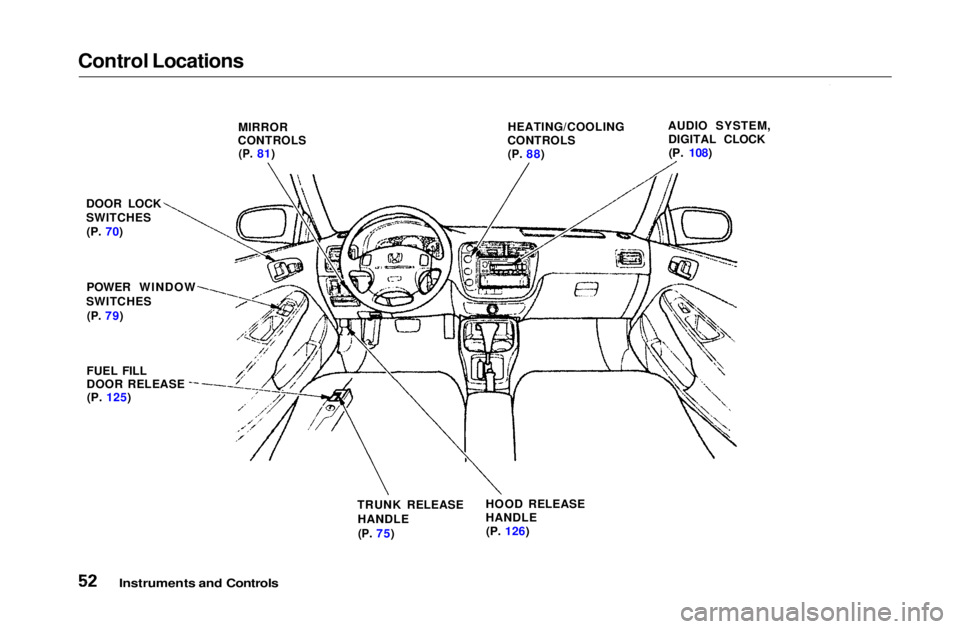
Control Locations
MIRROR
CONTROLS
(P.
81) HEATING/COOLING
CONTROLS
(P.
88) AUDIO SYSTEM,
DIGITAL CLOCK(P. 108)
DOOR LOCK
SWITCHES (P. 70)
POWER WINDOW
SWITCHES
(P.
79)
FUEL FILL
DOOR RELEASE (P. 125)
TRUNK RELEASEHANDLE
(P.
75) HOOD RELEASE
HANDLE
(P. 126)
Instruments and ControlsMain Menu Table of Contents s t
Page 62 of 269
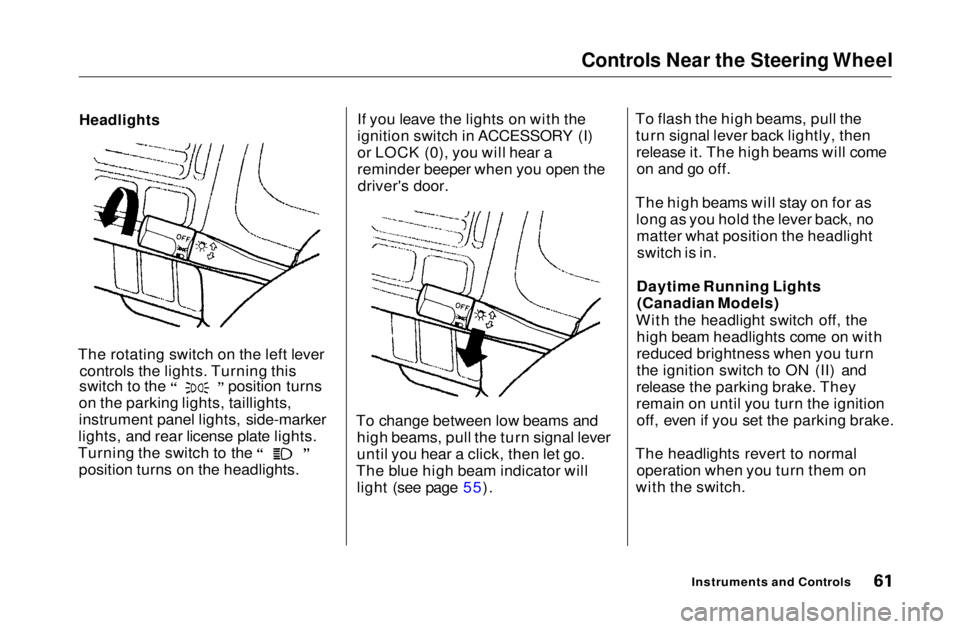
Controls Near the Steering Wheel
Headlights
The rotating switch on the left lever controls the lights. Turning this switch to the position turns
on the parking lights, taillights,
instrument panel lights, side-marker
lights, and rear license plate lights. Turning the switch to the
position turns on the headlights. If you leave the lights on with the
ignition switch in ACCESSORY (I)
or LOCK (0), you will hear a
reminder beeper when you open the
driver's door.
To change between low beams and high beams, pull the turn signal lever
until you hear a click, then let go.
The blue high beam indicator will light (see page 55). To flash the high beams, pull the
turn signal lever back lightly, thenrelease it. The high beams will comeon and go off.
The high beams will stay on for as long as you hold the lever back, nomatter what position the headlightswitch is in.
Daytime Running Lights (Canadian Models)
With the headlight switch off, the high beam headlights come on with
reduced brightness when you turn
the ignition switch to ON (II) and
release the parking brake. They
remain on until you turn the ignition off, even if you set the parking brake.
The headlights revert to normal operation when you turn them on
with the switch.
Instruments and ControlsMain Menu Table of Contents s t
Page 70 of 269
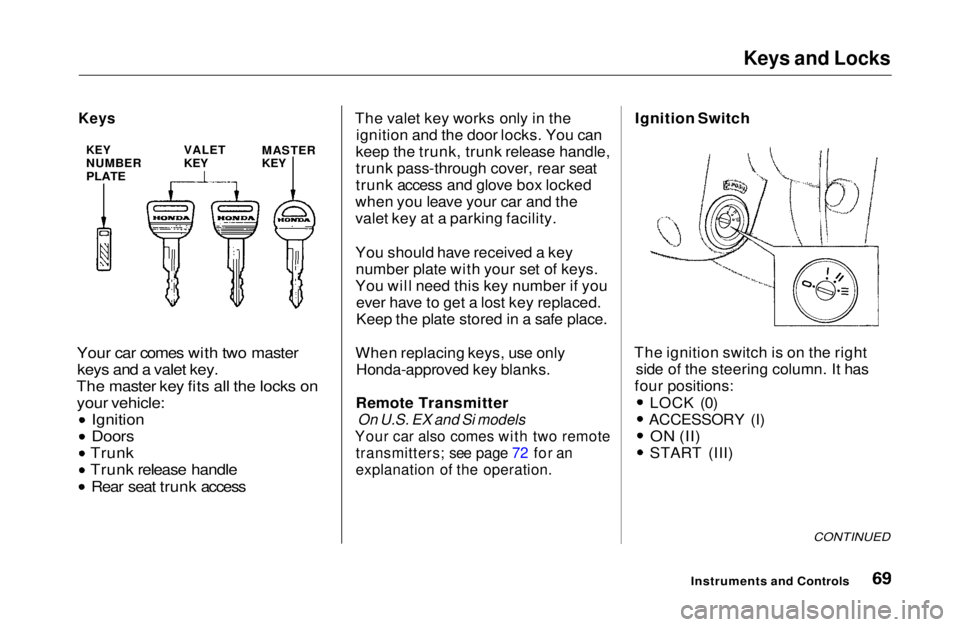
Keys and Locks
Your car comes with two master keys and a valet key.
The master key fits all the locks on your vehicle: Ignition
Doors
Trunk
Trunk release handle Rear seat trunk access
The valet key works only in the
ignition and the door locks. You can
keep the trunk, trunk release handle,
trunk pass-through cover, rear seat
trunk access and glove box locked
when you leave your car and the
valet key at a parking facility.
You should have received a key number plate with your set of keys.
You will need this key number if you ever have to get a lost key replaced.
Keep the plate stored in a safe place.
When replacing keys, use only Honda-approved key blanks.
Remote Transmitter
On U.S. EX and Si models
Your car also comes with two remote
transmitters; see page 72 for an
explanation of the operation.
Ignition Switch
The ignition switch is on the right side of the steering column. It has
four positions:
LOCK (0)
ACCESSORY (I)
ON (II)
START (III)
CONTINUED
Instruments and Controls
Keys
KEY
NUMBER
PLATE
VALET
KEY
MASTER
KEYMain Menu Table of Contents s t